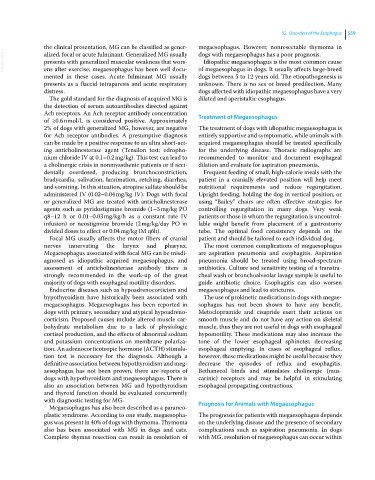Page 591 - Clinical Small Animal Internal Medicine
P. 591
52 Disorders of the Esophagus 559
the clinical presentation, MG can be classified as gener- megaesophagus. However, nonresectable thymoma in
VetBooks.ir alized, focal or acute fulminant. Generalized MG usually dogs with megaesophagus has a poor prognosis.
Idiopathic megaesophagus is the most common cause
presents with generalized muscular weakness that wors-
ens after exercise; megaesophagus has been well docu-
dogs between 5 to 12 years old. The etiopathogenesis is
mented in these cases. Acute fulminant MG usually of megaesophagus in dogs. It usually affects large‐breed
presents as a flaccid tetraparesis and acute respiratory unknown. There is no sex or breed predilection. Many
distress. dogs affected with idiopathic megaesophagus have a very
The gold standard for the diagnosis of acquired MG is dilated and aperistaltic esophagus.
the detection of serum autoantibodies directed against
Ach receptors. An Ach receptor antibody concentration Treatment of Megaesophagus
of ≥0.6 nmol/L is considered positive. Approximately
2% of dogs with generalized MG, however, are negative The treatment of dogs with idiopathic megaesophagus is
for Ach receptor antibodies. A presumptive diagnosis entirely supportive and symptomatic, while animals with
can be made by a positive response to an ultra short‐act- acquired megaesophagus should be treated specifically
ing anticholinesterase agent (Tensilon test: edropho- for the underlying disease. Thoracic radiographs are
nium chloride IV at 0.1–0.2 mg/kg). This test can lead to recommended to monitor and document esophageal
a cholinergic crisis in nonmyasthenic patients or if acci- dilation and evaluate for aspiration pneumonia.
dentally overdosed, producing bronchoconstriction, Frequent feeding of small, high‐calorie meals with the
bradycardia, salivation, lacrimation, retching, diarrhea, patient in a cranially elevated position will help meet
and vomiting. In this situation, atropine sulfate should be nutritional requirements and reduce regurgitation.
administered IV (0.02–0.04 mg/kg IV). Dogs with focal Upright feeding, holding the dog in vertical position, or
or generalized MG are treated with anticholinesterase using “Bailey” chairs are often effective strategies for
agents such as pyridostigmine bromide (1–3 mg/kg PO controlling regurgitation in many dogs. Very weak
q8–12 h or 0.01–0.03 mg/kg/h as a constant rate IV patients or those in whom the regurgitation is uncontrol-
infusion) or neostigmine bromide (2 mg/kg/day PO in lable might benefit from placement of a gastrostomy
divided doses to effect or 0.04 mg/kg IM q6h). tube. The optimal food consistency depends on the
Focal MG usually affects the motor fibers of cranial patient and should be tailored to each individual dog.
nerves innervating the larynx and pharynx. The most common complications of megaesophagus
Megaesophagus associated with focal MG can be misdi- are aspiration pneumonia and esophagitis. Aspiration
agnosed as idiopathic acquired megaesophagus, and pneumonia should be treated using broad‐spectrum
assessment of anticholinesterase antibody titers is antibiotics. Culture and sensitivity testing of a transtra-
strongly recommended in the work‐up of the great cheal wash or bronchoalveolar lavage sample is useful to
majority of dogs with esophageal motility disorders. guide antibiotic choice. Esophagitis can also worsen
Endocrine diseases such as hypoadrenocorticism and megaesophagus and lead to strictures.
hypothyroidism have historically been associated with The use of prokinetic medications in dogs with megae-
megaesophagus. Megaesophagus has been reported in sophagus has not been shown to have any benefit.
dogs with primary, secondary and atypical hypoadreno- Metoclopramide and cisapride exert their actions on
corticism. Proposed causes include altered muscle car- smooth muscle and do not have any action on skeletal
bohydrate metabolism due to a lack of physiologic muscle, thus they are not useful in dogs with esophageal
cortisol production, and the effects of abnormal sodium hypomotility. These medications may also increase the
and potassium concentrations on membrane polariza- tone of the lower esophageal sphincter, decreasing
tion. An adrenocorticotropic hormone (ACTH) stimula- esophageal emptying. In cases of esophageal reflux,
tion test is necessary for the diagnosis. Although a however, these medications might be useful because they
definitive association between hypothyroidism and meg- decrease the episodes of reflux and esophagitis.
aesophagus has not been proven, there are reports of Bethanecol binds and stimulates cholinergic (mus-
dogs with hypothyroidism and megaesophagus. There is carinic) receptors and may be helpful in stimulating
also an association between MG and hypothyroidism esophageal propagating contractions.
and thyroid function should be evaluated concurrently
with diagnostic testing for MG. Prognosis for Animals with Megaesophagus
Megaesophagus has also been described as a paraneo-
plastic syndrome. According to one study, megaesopha- The prognosis for patients with megaesophagus depends
gus was present in 40% of dogs with thymoma. Thymoma on the underlying disease and the presence of secondary
also has been associated with MG in dogs and cats. complications such as aspiration pneumonia. In dogs
Complete thymus resection can result in resolution of with MG, resolution of megaesophagus can occur within

